Hasegawa 1/48 Typhoons
It's hard to believe these cardoor and bubbletop Typhoons from Hasegawa are going on 15 years old, but the cardoor kit was released in the summer of 1998, with the bubbletop released that fall.
Traditionally, the hallmark of a successful aircraft manufacturing company has been that future requirements should always be the concern of the Chief Designer and the project team. In other words, when the latest project has been accepted for production, its replacement should be on the drawing board. Sir Sydney Camm, Hawker Aircraft's Chief Designer and one of the true legends of aircraft design alongside Ed Heineman and Kelly Johnson, was already hard at work in the summer of 1937 on the Hurricane's replacement - to meet Air Ministry Spedification F.18/37 which called for a fighter with a top speed over 400 m.p.h. - when the first production model of that famous airplane had yet to fly. The result was - at the time the first prototype was rolled out - the biggest single-seat, single-engined fighter ever designed, with the heaviest armament any traditional fighter had ever carried, with the most powerful aero engine ever installed in an airframe. Unfortunately, not enough was known at the time of its design to prevent it being equipped with a wing too thick for what was really needed, which would always hold it back in fighter versus fighter performance. The exigencies of war would dictate that the airplane was committed to production too early in the development cycle, resulting in it acquiring a worse reputation with its pilots than any fighter that ever preceded it, a dangerous reputation that was fully deserved at the outset and would cost the lives of many young fighter pilots to resolve.
In the end, all the heartache would be justified, as it became the primary weapon of close air support alongside the P-47 Thunderbolt, covering the victorious Allied armies as they swept across northwestern Europe in the breakout from Normandy. As a killer of German armored vehicles, it would only be out-done by the Russian Sturmovik.
Ordered "off the drawing board" in 1939, the prototype Typhoon flew on February 24, 1940. Flight testing quickly revealed the effects of compressibility, of which little was known at the time. The thick wing also resulted in extreme slipstream buffet around the wing roots, due to the fact the engine was fitted as close to the leading edge of the wing as possible to preserve c.g. balance. Unknown at the time was the fact that the buffet also created a disturbed slipstream along the entire fuselage that became quite violent by the time it reached the tail. It would be early 1943 before it was discovered the fuselage/tail joint was not strong enough to withstand these forces in a maximum-velocity dive and the joint would be reinforced with the fishplates so prominent on the Typhoon afterwards. Nineteen pilots died due to catastrophic tail separation discovering this, the result of the speeded-up development process. The cannon-armed Typhoon IB appeared in early July 1941. By that fall, the RAF had encountered the Focke-Wulf Fw-190, and needed the Typhoon more than ever. 56 Squadron at Duxford received their first Typhoons in September 1941; they were followed in January 1942 by 266 "Rhodesian" squadron and 609 "West Riding" Squadron that following March. Due to the lack of development, these squadrons would by necessity become part of the flight testing of the Typhoon to unearth solutions to its many faults. One of the first items the pilots of 56 discovered was that the pilot had to wear his oxygen mask at all times, due to the leakage of carbon monoxide into the cockpit from the engine compartment.
The price of the premature introduction of the Typhoon was high. Despite being issued to 56 Squadron in September 1941, the first operational sortie - an interception of a "bogie" that turned out to be a Spitfire - was not flown until May 28, 1942; the first sweep was flown on June 20. During the first nine months of operations, far more Typhoons were lost due to structural failure or engine trouble than were lost on operations; between July and September 1942, it was estimated at least one Typhoon in four failed to return from an operational sortie as a result of one of its many defects.
The cardoor Typhoon here represents the airplane flown by Flying Officer "Cheval" Lallemant, one of the Belgian pilots assigned to 609 Squadron and one of the original pilots to check out in the Typhoon. On January 20, 1943, the Germans staged an incredible daylight raid on London with 50 Fw-190 Jabos supported by the rest of JG26 and JG2. Lallemant scored in the huge air battle that developed as the Fw-190s dropped their bombs at 20,000 feet and turned to dive back to France. On February 14, 1943, Lallemant and his wingman, Tony Polek, were detailed to provide cover for a crippled MTB in the Channel. Attacked by four Fw-190s of JG26, Lallemant managed to shoot one off his wingman's tail as Polek nailed the one he was after; ten minutes later four more Focke-Wulfs turned up to play, and Lallemant got his second with a high deflection shot in which he could not see the results of his fire until the wing of the Fw-190 flipped over him and the fireball that had been the fighter went into the Channel upside down. He then shot at another, which was credited as a "probable," though the "Y": listening service later confirmed it destroyed. Like most Typhoon combats, this took place at such a low level that flying into the sea inadvertently was something a pilot had to keep in his mind if he was to survive. Had Lallemant been credited with the third Focke-Wulf on February 14, he would have been the first Typhoon "ace." On January 14, 1944, flying with 197 Squadron, he shot down an Me-210, though the Wing Leader would not confirm it because he was angry Lallemant had requested transfer to another squadron. After D-Day, Lallemant located the wreckage of this Me-210 and was credited with the victory. His "official" fifth kill came on February 26, 1944, while flying with 198 Squadron - a Bf-110G night fighter off Dunkirk flown by a 54-victory experte, Oberfeldwebel Helmut Vinke of IV.NJG1.
In February, 1944, all Typhoon squadrons except 137 Squadron in Fighter Command were transferred to 2nd Tactical Air Force, the RAF's contribution to air support of the upcoming invasion. The squadrons learned to use both the 60-lb RP and general purpose bombs. The training was put to use over the Channel coast with attacks on the V-1 launch sites under construction, and losses were heavy at low level under fire from the massive number of light flak positions defending these sites.
The first "bubbletop" Typhoon appeared in September 1943. The bubble canopy gave the Typhoon pilot the best all-round vision of any fighter used by any combatant at the time, and its influence was seen within six months with the introduction of the P-51D Mustang and later-production P-47D Thunderbolt, both of which featured bubble canopies. The slow delivery of this modification meant that bubbletops which reached the squadrons were reserved for squadron and flight leaders. The last "car-door" Typhoons did not leave first-line service until March 1944.
On June 6, 1944, the Typhoon was the main RAF fighter-bomber supporting the invasion. By this stage, the system of forward air control that had first begun in the North African campaign and had been honed in the Italian campaign, insured that air support was able to be given as closely and accurately as the weapons themselves would allow. The Forward Air Controller, who was a pilot, was equipped with a vehicle that had aircraft radios. The controller could vector in fighter bombers by telling them the ground features to look for that a pilot would notice. The Typhoons patrolled the front lines in what was known as "cab rank" formation, in which a flight would be called in by a controller, execute an attack, and return to base for refueling and rearming, while other flights were constantly overhead.
The Typhoon as a rocket-armed airplane with the explosive punch of a light cruiser became so successful that all memory of the troublesome fighter of a year previously was forgotten. That was not to say that the airplane was faultless; "F for Freddie" of 198 Squadron - modeled here - carried the following instructions on its lower cowl: "If this engine catches fire on starting, don't just wave your arms at the pilot. Try putting the bloody thing out as well!"
In building either kit, the main problem is the fuselage. Due to the poor engineering of the center section - which is done to allow the kit to be released as either a cardoor or bubbletop - I recommend you attach each cockpit part to the separate fuselage half before assembling the fuselage. This will allow you to get as good a fit to the parts as possible. When you then assemble the fuselage halves, there will be a gap down the center joint of the center section, which can be filled with a piece of .010 evergreen strip. Unfortunately, none of the joints of this assembly run along panel lines, so you will particularly need to ensure the best fit possible when attaching the parts, and will then need to use more than a bit of surfacer, likely with repeated application, to successfully fill in the seams. This is crucial - failing to do so will ruin the look of the model. Everything else is straightforward.
Decals for both aircraft came from an Aeromaster sheet, the number of which I forget, but it's no longer in production anyway.

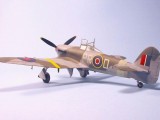
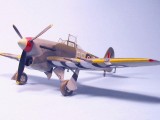
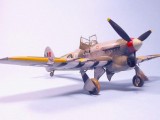
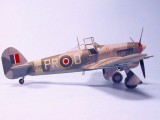
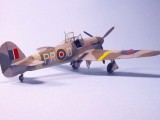
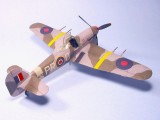


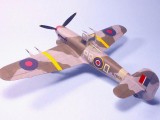
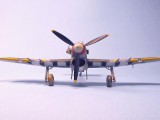
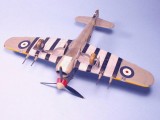

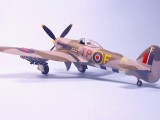
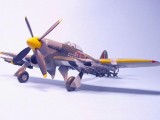
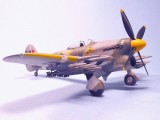

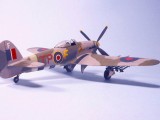
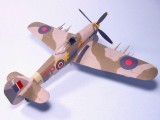
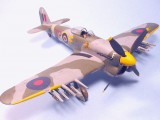
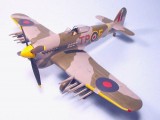
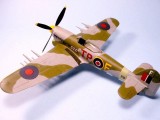
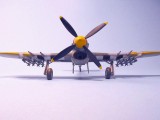

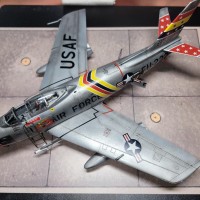
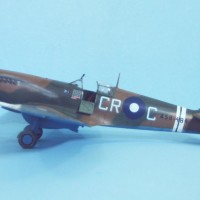
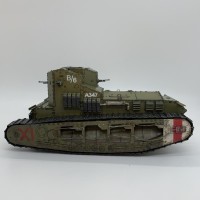
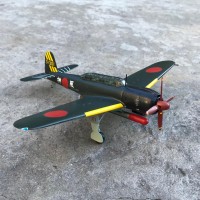
Your right I am amazed how fast these kits seems to age. I got the car-door Typhoon pretty much when it was 1st released from Hasegawa. Time just flies, is it me or does it run in cycles like the way new releases are being announced this year. Anyway both of your Tiffies are nicely done. i only have built the car-door version, I may have built the old Monogram bubbletop years ago. Subtle weathering enhances both of them. And I really like the history and timeline of this variant. Thanks for the presentation and taking the time to present it. Well done. I learned a little bit more about the Typhoon and its order of battle. Thanks for sharing
Chuck
Interestingly, the Monogram Typhoon stands the test of time almost as well as their P-39. Not much in the way of cockpit detail, but any study of the cockpit shows that a few pieces of Evergreen rod and sheet and good hand-eye coordination will solve that easily. Overall the kit is accurate (has the Tempest tailplanes right for a 4-blader) and a few minutes rescribing panel lines (if you feel you really need to) and a shopping trip for one of the old Aeromaster decal sheets, and you've got a nice model. The Falcon/Squadron vac canopy is icing on the cake.
They certainly look the business. Nice models, and lots of info as well!
Tom... Great looking models and thanks for the background history, enjoyable as usual to read.
Thanks for the history lesson Tom good job
Tom,
Very much enjoyed your comments and history of the Typhoon. I have always liked this brute even better than the Tempest. It just looks tough like a good street fighter. Very interesting aside on the wearing of the oxygen mask. I have built Hasagawa's and a number of Monograms. I agree, Monograms still holds up well. Great looking models. Where do you find the time to build so many models.
Where do I find the time to build so many models?
1: these builds I've been posting are over several years.
2: writing (for me) involves short periods of intensive typing, followed by looooong periods of frustration; such frustration is best dealt with by sitting down with a model rather than the other vices writers are known to be vulnerable to. 🙂
3: self (un)employment. 🙂
man that's sweet...one of my favorite planes